Columbia Police Officer strives for perfectly placed lead shots before “Rescuing the Downed Officer”.
By Capt. Tom Dresner
His breathing was labored as he tried to inhale deeply. Every breath was like sucking air through a straw. Same with the exhale. Small drops of sweat trickled from his temples, yet he was unable to wipe them away. The shape of the mask prevented it. He glanced down at the MP5 held in his hands at his well practiced low-ready. The Navy group was selected to full, finger off trigger. He was very familiar with the ritual. He had done it countless times before.
His vision blurred as he awaited the start signal, and he thought to himself, “They sure named this course of fire correctly— Foggy Gasmask Blues.” He wondered how bad the fog would be by the end of the course. Would he still have a clear enough sight picture to prevent a hit on a closely placed no shoot target?
After it was over, the he let the MP5 hang against the sling, then safety on, bolt back, mag off, physically and visually inspect the chamber. Clear. One event down, three more individual events, one two man team event, and the four man team event left to go.
The Second Annual Midwest Police/SWAT SMG Championships is now in the history books. It was held at the Green Valley Rifle and Pistol Club/Chapman Academy of Practical Shooting, in Columbia, Missouri. On March 27, 1999, 60 tactical officers from units in Missouri and Kansas police departments joined to hone their MP5 skills while competing for some very exciting prizes this year. Officers competed individually for a tactical school of their choice, compliments of Heckler & Koch, and first place individual officer was able to claim a .40 caliber USP Compact pistol with night sights as a reward for his efforts.
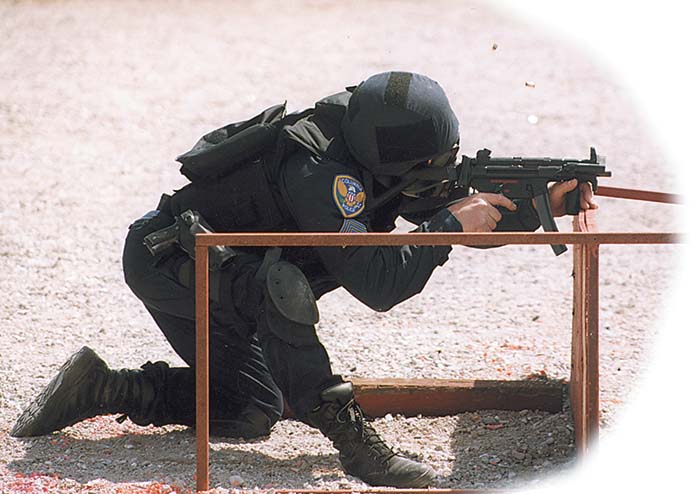
13 four-man teams competed for the most coveted prize of all, an actual MP5 for their department’s tactical unit. We budgeted $1300 toward the cost of the winning team’s variant of choice. With the stakes this high, not to mention the bragging rights, the competition was intense.
This match was conceived by members of our tactical unit as a fun way of combining training and competition featuring the submachine gun as it was intended to be fielded in actual operations. Though probably the most versatile weapon that can be chosen by SWAT units in contemporary operations, it is most useful in entries for encountering hostile targets between contact and 10 yard distances, fired from the shoulder and on full automatic. Thus we designed our rules around those parameters.
Because civilian police tactical teams are expected to have a zero casualty rate for innocents and themselves, accuracy is of the utmost importance. Therefore, we designed the courses to demand the utmost accuracy, and to severely punish hits on no-shoot or hostage targets. Last year’s champion, Lt. Mitch Brim of the Shawnee, KS Police Department knows first hand of what I speak. Mitch took fifth this year, and would have recaptured the title, and the USP40C, were it not for only one hostage target hit. First place to fifth with one shot. Losing the gun was extra painful I am sure, but only a shadow of the consequences of it occurring in real life.
We use a scoring system that rewards accuracy over speed, and makes it impossible for someone to blaze peripheral shots on a target faster than an officer who tears out the center. Quite simply, the officer who shoots the most accurately, the fastest, will win any given event. The scoring is called Chapman Count, and is by far the most easy of all scoring systems to use. It is named for Ray Chapman, the great practical shooting patriarch who used to own the facility we shot on that day. He is now retired, and living in Texas. Score minus time, with targets scored 10-5-2 on standard IPSC targets.
IPSC was born in Columbia, Missouri in 1976 at the Columbia Conference. IDPA, the newest practical shooting sport was born in Arkansas, founded largely by Bill Wilson, one of the original IPSC founders. IDPA was born out of a sense of frustration at the space gun arms race and gamesmanship that IPSC gave rise to over the years, and IDPA successfully addresses many of those problems by strict rules on equipment for a more “practical” feel. Quite disappointingly however, they fall short in the most important aspect of the sport, no matter what type of firearm is used. Scoring. In IDPA, a faster shooter with peripheral hits can still beat someone who is more accurate, but slower, even with shots that miss the target. With Chapman count, every point is a second, and that means one miss will cost 10 seconds for each shot off target. That is impossible to recover from, and discourages indiscriminate blazing.
The match consists of four individual events, one two man team event, and one four man team event. The aggregate of the individual matches determines the individual champion, and the team events are scored separately.
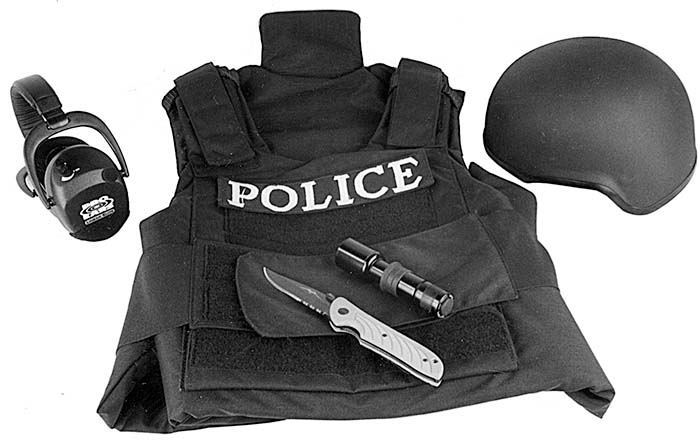
To keep things operationally authentic, we require the competitors to wear full tactical gear, to include body armor, ballistic helmets which are ubiquitous among American SWAT units currently, BDUs, boots and one event fired with the gas mask. We do not allow the use of double magazine clamps, since they are seldom used operationally, due to how heavy the MP5 becomes with 60 rounds on the gun. Though there are some units in the Midwest who use the Colt SMG, none were present at the match, and all guns present were some variant of the MP5, some in .40 caliber, with SD and PDW models in evidence as well. The MP5SD causes our range officers fits, because often the gun is too quiet for the electronic timers to “hear” the shots being fired.
Our tactical team is a member of the Midwest Tactical Officers Association, a regional cadre of teams dedicated to sharing information, training opportunities, seminars and debriefs. It allows different teams to work together and share information about how we do things. It also allows us to host a match like this, mindful of the capabilities of the units represented, yet still not push the safety envelope into a hazardous area. The members of this association are all quite competent, and safety rules are enforced vigorously.
Throughout the day, individual officers hammered away at the solo events, each studying other techniques, and grilling teammates on strategies to shave seconds here or there. The natural competitiveness of the American SWAT officer was in plain view throughout the day.
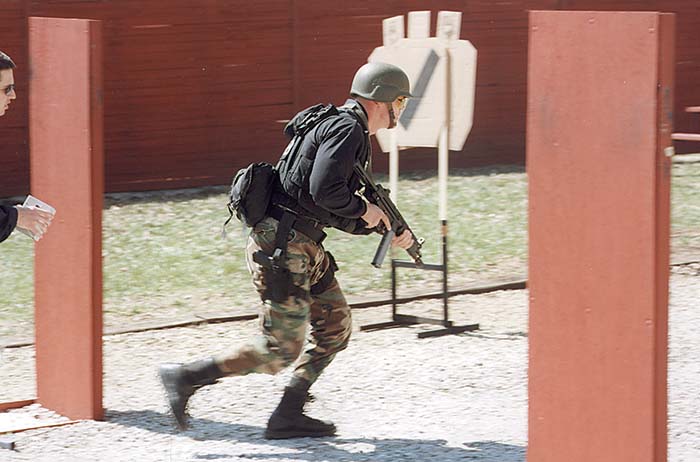
Because of a function close by in time and location, Mark Kunnath from the Heckler & Koch International Training Division was able to stop by with his “candy wagon” and demo some of the latest from HK during lulls in the shooting. A crowd of officers gathered quickly as Mark demo’d the new UMP, the first .45 caliber SMG from HK combining the parentage of the defunct prototype MP2000 with the polymer technology of the G36 series. At the time, it was one of only seven units in the United States. By the time you read this, it should be widely available.
Speaking of the G36 series, also present was the G36K carbine. I predict hefty sales of this new “wundergun” as word of its performance characteristics spreads in the world tactical community. I think it will give the venerable M16 serious competition in the years to come. The officers took turns firing the guns and commenting on how much they liked them, the only negative comment being that they could not buy one for themselves.
By 2:00 p.m., the ranges fell silent as the four individual and two man team events had been fired by all officers. Our range officers scrambled to assemble the event everyone waited for all day, and to see who would win the MP5. I named the match “The Long Road Home,” and made it so that the officers would be sucking wind and tearing off their armor at the end. I guess I wanted to see some work for that MP5.
The stage began much as last year, with the four team members seated in our raid van with a designated door breacher and this year with a designated NFDD deployer. NFDD stands for Noise Flash Diversion Device, the correct name for what is more commonly known as a “flash-bang”, and registered with the NFA Branch as destructive devices. We provided each of the 13 teams with one, which they deployed through the door prior to “entry” and beginning the actual firing sequences.

After “entry,” the officers fanned out into designated firing lanes and simultaneously advanced on their respective series of targets, all firing on the move. They were then met with a moving target, with four small balloons embedded in each. They had a total of six seconds to hit all four balloons before reloading and then advancing to a gantry and the next stage. After crossing the gantry, the officers went to pre-strategized shooting positions to maximize their economy of movement, and thus the saving of time.
The first of two allowed semiautomatic shots of the day was taken to “clear” a bridge of a lone hostile target, a falling plate with a no shoot target directly behind it to place additional pressure for accuracy on the shooter. This shot allowed the other three officers to advance across the bridge to the final shooting stage about 200 yards away. Safe gun handling was the rule as the officers made their way to engage the final series of targets. Upon completion of that series, they had to rejoining the “sniper” and advise him that he was clear to fire the final shot that stopped the timer.
Safety was enforced throughout the day, and it resulted in the disqualification of three teams, one on the two man team event and two teams on the four man team event, for violations of rule two, the laser rule.
Top three standings for “The Long Road Home” were as follows:
•1.Shawnee, Kansas Police Department (Winner of MP5)
•2.Lee’s Summit, Missouri Police Department
•3.Springfield, Missouri Police Department
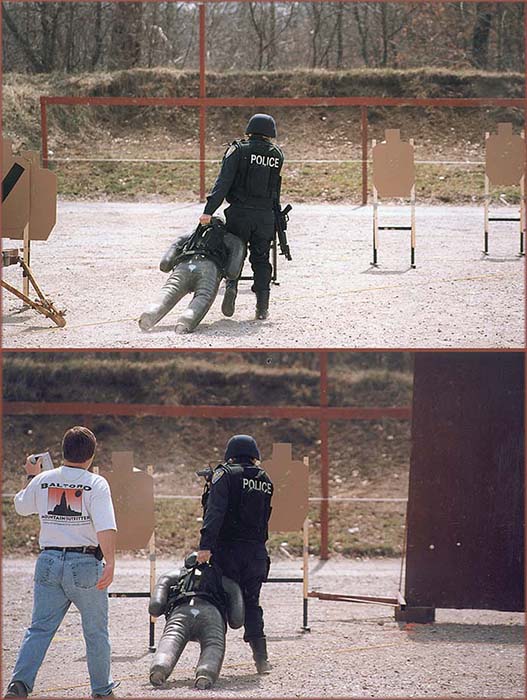
By the conclusion of the four man team event, the guns were stowed, and the gear went back to the trunks of the cars. The clubhouse came alive with the sounds of tactical officers and their families enjoying the evening, waiting for dinner and discussing what they should have or could have done on a particular stage, and how they would all include more gas mask training for the most difficult MP5 shooting of all, with a mask on.
The awards were presented and the top three two man teams and top five individuals are listed below:
1. Mitch Brim and Rob Maser, Shawnee, KS Police Department
2. Vaughan Baker and Rod Scoffer, Lee’s Summit, MO Police Department
3. B.J. Johnson and Joey Mattock, Christian Co., MO Sheriffs Department.
The top five individuals are as follows:
•Champion and winner of HK USP40C: George Gardner, N. Kansas City, MO Police Department
•Second place and winner of HK IT School: Aaron Driscoll, Christian Co. MO Sheriffs Department
•Third: Jerry Greens, Columbia, MO Police Department
•Fourth: Frank Bunny, Independence, MO Police Department
•Fifth: Mitch Brim, Shawnee, KS Police Department
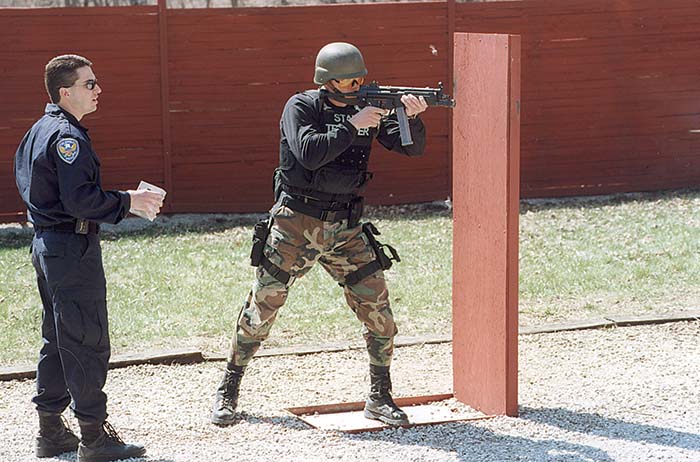
This individual victory was particularly sweet for Officer Gardner. He had asked his chief prior to coming to the match for training time for the match and was told, not only no training time, but do not use any department equipment, to include uniforms, vest, MP5 or anything else. He borrowed an MP5 and helmet, and bought an Eagle TAC vest with his own money and wore personally owned gear to round out what he needed. He had commented to me about this story early in the day, and how he had hoped that he could win something to take back and make the department proud anyway. He did that, and a lot more. As you can see, backing for SWAT is not universal, yet the caliber of individual officers who choose it transcends sometimes flagging support, and brings out the best in us anyway.
The Third Annual Midwest Police/SWAT SMG Championships will be held again in early April, 2000.
| This article first appeared in Small Arms Review V3N7 (April 2000) |











